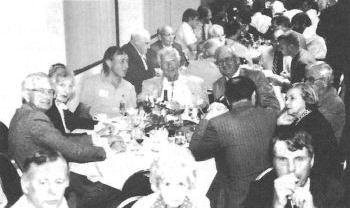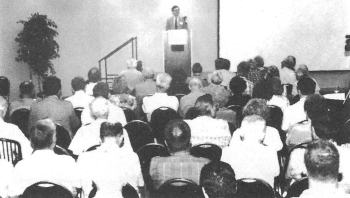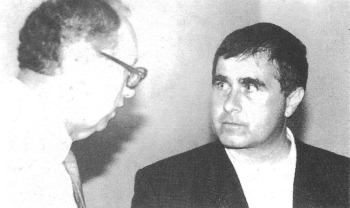Defying Powerful Adversaries, Institute Marks Progress
Spirited Twelfth IHR Conference Brings Together Leading Revisionist Scholars and Activists
From across the United States and several foreign countries, scholars, activists, and friends of the Institute for Historical Review met over the September 3–5 weekend in southern California for the IHRs landmark Twelfth International Revisionist Conference.
This Conference, one of the most spirited and successful ever, featured leading figures in the growing international revisionist movement. It was characterized, attendees agreed, by high morale and a confident sense of progress. About 125 men and women attended the Conference, which met in a pleasant hotel meeting hall in Irvine.
Leading revisionist activists provided attendees with the exciting inside story about major achievements, as well as the latest efforts of our adversaries, in the international campaign for greater historical awareness about the most hyped and taboo-laden chapters of history. In addition, prominent revisionist scholars shared new research discoveries and breakthrough insights that further shatter major icons of official history. (As usual, Conference presentations are available on audio- and video-tape cassettes, and most will also be published in the Journal.)
Underscoring its international tone, Conference speakers arrived from Italy, France, Switzerland, Britain and Canada, as well as the United States, while attendees from Finland, Argentina, Britain and Switzerland were among those who traveled to southern California specifically to attend this meeting.
As at previous IHR conferences, attendees took advantage of this opportunity to meet personally and talk privately with the speakers and fellow attendees, many of whom are themselves important revisionist activists.
This gathering, one of the most informative, inspiring and memorable ever, was particularly important in light of the major developments since the last, Eleventh IHR Conference in October 1992.
In his familiar riveting and entertaining style, best-selling British historian David Irving presented startling new facts and insights about Joseph Goebbels, based in large part on his headline-making research in Moscow archives of the Third Reich propaganda chiefs long-hidden personal diaries.
At the last IHR Conference, Irving explained how he was able to gain access to the diaries, which were recorded on fragile glass plates. Having in the meantime carefully evaluated this priceless historical material, Irving related new findings and insights from this and other sources to present a fuller and more rounded portrait of Hitlers propaganda chief, and of the internal life of the Third Reich.
Contrary to the popular propaganda image, said Irving, Goebbels animosity against the Jews, which was more severe than Hitlers, reached its full intensity only after, and in response to, the Jewish wartime propaganda campaign against Germany.
Spicing his presentation with anecdotes about Goebbels private life, Irving discredited the propaganda image of him as a profligate womanizer. In fact, Irving related, Goebbels sexual experiences were quite limited.
Speaking about the notorious Kristallnacht outburst of anti-Jewish violence in Germany on November 9, 1938, Irving pointedly took issue with the thesis of German revisionist historian Ingrid Weckert, who addressed the Sixth, 1985 IHR Conference. (On that occasion, Weckert presented evidence to suggest that Goebbels had no advance knowledge of the Kristallnacht outburst, and that the violence may have been incited by anti-German agents provocateurs. Weckerts thesis is detailed in her book Flashpoint, published by the IHR.)
In fact, said Irving, the evidence shows that Goebbels played the crucial role in inciting the anti-Jewish Crystal Night violence.
This disagreement between Irving and Weckert – which Irving referred to as a revisionist revising a revisionist – is precisely the kind of thoughtful disputation among revisionist scholars (including IHR conference speakers) that points up the intellectual vitality and integrity of the Institute for Historical Review.
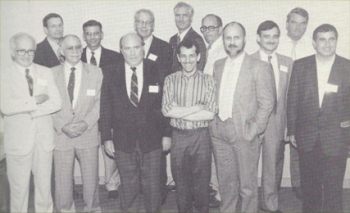
Speakers at the Twelfth IHR Conference (from left to right): Robert Faurisson, John Ball, Russ Granata, Carlo Mattogno, Ernst Zündel, Friedrich Berg, Greg Raven, David Cole, Robert Countess, Tom Marcellus, Mark Weber, David Irving and Jürgen Graf.
David Irving
Irving, one of the worlds most prolific historians, also updated attendees on the ever more frantic international campaign to muzzle him – and all others who dare to defy the powerful worldwide Holocaust lobby. He told about his new lawsuit against the Canadian government for unlawful detention during his 1992 speaking tour – an arrest that was later cited by the New Zealand and Australian governments to justify their own bans against him.
As at previous IHR conferences, Irving sold and autographed copies of his books.
Ernst Zündel
German-Canadian publicist and civil rights activist Ernst Zündel delivered the Sunday evening banquet address. His appearance was particularly welcome because, although he attended the first IHR conference in 1979, he had been barred by the US State Department from entering this country to address several subsequent IHR conferences.
Zündel devoted the first part of his banquet presentation to an eloquent expression of gratitude for all those who, over the years, have contributed significantly to the revisionist cause. He expressed special appreciation for the role of the Institute for Historical Review, and took time to remember friends and supporters who are no longer alive, including Frank Walus, Joseph Burg, Dr. William Lindsey and IHR co-founder David McCalden. Zündel related all this to his two widely publicized Holocaust trials (1985 and 1988), which brought major breakthroughs for historical revisionism and an important victory for free speech in Canada.
During the second portion of his presentation, he reported on his recent visit to Russia, where he met with important Russian nationalist figures, including Vladimir Zhirinovsky, the prominent opposition political leader.
In the wake of the collapse of Communism, said Zündel, a process of full-scale historical revisionism is now taking place in Russia. People are enduring a drastic, soul-searching re-evaluation of their national history and collective self-identity. This includes a dramatic reassessment of the Second World War. Oddly enough, said Zündel, many nationalist Russians view both Stalin and Hitler rather sympathetically.
Predicting that Russia would take a course that is neither Communist nor liberal-democratic/Capitalist, Zündel spoke with hope about the possibilities of future close collaboration between a revived, nationalist Russia and a revived, nationalist Germany.
Zündel, who was interviewed by journalist Mike Wallace for an appearance on a March 1994 broadcast of the popular 60 Minutes television show, has been devoting considerable time in recent months to a new international television and radio broadcast outreach campaign.
Robert Faurisson
Robert Faurisson delighted attendees with a fascinating and witty description of his visit, just days earlier, to the US Holocaust Memorial Museum in Washington, DC, where he met with Museum official Michael Berenbaum in his office.
Faurisson spoke with Berenbaum about the model on display at the Museum of Auschwitz-Birkenau Crematory II, which shows an SS man pouring Zyklon B in vents on the roof of the supposed gas chamber and through perforated pillars. This model, the French scholar told Berenbaum, is preposterous because, as any visitor to Birkenau can determine for himself, there are no vents or regular holes in the roofs of the supposed gas chamber. Berenbaum made no effort to defend the model, said Faurisson.
Faurisson asked Berenbaum why the Museum had not answered his challenge to Show me or draw me a Nazi gas chamber! (See the Jan.–Feb. 1994 Journal, p. 23.) After some prodding, Berenbaum eventually related that the decision has been made not to give any physical representation of the Nazi gas chambers.
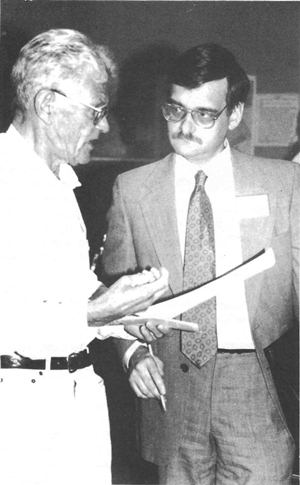
At the Twelfth IHR Conference, Swiss educator Arthur Vogt tells Journal editor Mark Weber about revisionist work in Europe.
In response to Faurissons pointed questions and comments, Berenbaum angrily lost control of himself. I thought he was going to smack me, said Faurisson.
Faurisson, a French university professor (and frequent Journal contributor), was the first person to dig up and publish key documents from the Auschwitz construction department archives. After attempting for years to ignore this evidence, his hard-pressed enemies are now obliged to offer responses, albeit confused ones.
For years he has been the victim of vicious media attacks and a campaign of legal persecution in his native France, where it is a crime publicly to challenge the currently fashionable view of the Holocaust extermination story.
Carlo Mattogno
Carlo Mattogno, Italys foremost revisionist scholar, explained that newly-uncovered German records held for years in Soviet archives, supported with other documentary and forensic evidence he has collected in years of research, thoroughly discredit claims of mass extermination of Jews at Auschwitz. His presentation summarized findings and conclusions of his new 150-page book, Auschwitz: The End of a Legend: A Critique of J. C. Pressac, which was published by the IHR just in time for sale at this Conference. Mattogno autographed numerous copies of the book for attendees.
Mattogno, a scholar of rare precision and exactitude with an impressive command of languages, cited copious evidence collected during years of meticulous research to explain that the crematories at Auschwitz simply were not capable of handling the number of corpses alleged to have been produced from the supposed extermination process. Even if operated at maximum capacity, the crematory ovens could not possibly have handled anything like the numbers of corpses alleged.
Appearing with Mattogno as his translator was Russ Granata, a retired southern California teacher who provided critical help in making possible the publication of Auschwitz: The End of a Legend.
Jürgen Graf
Jürgen Graf, a Swiss educator with an impressive command of languages and an author of several carefully researched revisionist works, spoke about the perverse social-psychological role that the Holocaust story has come to play in Western political, social and cultural life. Graf has been active not only in the Holocaust revisionist movement, but also in the campaign to halt further non-European immigration into Switzerland.
Speaking with verve and wit, and in impressively-delivered English, Graf said that the Holocaust story has become a major weapon in the growing campaign to discredit Western culture and to break down European racial-cultural consciousness. It is used to subvert national sovereignty, and promote massive Third World immigration into North America and western Europe.
In Switzerland and other western European countries, as well as in the United States and Canada, popular sentiment overwhelmingly favors a halt to further Third World immigration. The refusal of elected public officials and the mass media to reflect this popular sentiment points up a profound failure of political institutions in the Western World, said Graf.
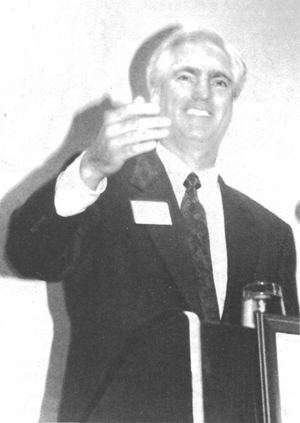
Master of Ceremonies Greg Raven kept the Twelfth Conference on track throughout the hectic three-day schedule.
Referring to the well-organized effort to introduce a legal ban on Holocaust revisionism in his own country (similar to such prohibitions in neighboring France and Germany), Graf boldly announced that he will openly defy any such ban.
In March 1993, following the publication of his 112-page book Der Holocaust auf dem Prüfstand (The Holocaust on the Test Stand), Graf was summarily dismissed from his post as a secondary school teacher of Latin and French, in spite of support from his students and colleagues. His firing came on orders of high-level Swiss authorities. Graf is also author of several other revisionist books, copies of which were available for sale, and which he autographed for attendees.
John Ball
John Ball, a western Canadian geologist who specializes in interpreting aerial photos used in mineral exploration, explained that much can be learned from Second World War aerial reconnaissance photographs. Ball has collected, studied and published scores of long suppressed reconnaissance photographs of German camps, including Auschwitz, Majdanek and Plaszow (featured in Schindlers List), as well as Babi Yar.
Illustrating his presentation with numerous slides of aerial photos, maps and diagrams, he provided devastating new insights into the suppressed history of Auschwitz and other alleged German extermination camps. Speaking with the confidence of a specialist, Ball showed a rare ability to make a rather technical subject easily understandable to lay persons.
Ball spent considerable time throughout the three-day Conference patiently answering questions by inquisitive attendees, inviting them to examine reconnaissance photos under a magnifying glass. Ball also displayed wall-mounted photo enlargements and diagrams, and he autographed copies of the unabridged edition of The Ball Report.
Friedrich Berg
Friedrich P. Berg, an engineer who has devoted extensive effort to researching technical aspects of the Holocaust story, pointed out that wartime Germany ironically did have an immense quantity of lethal gas at its disposal: wood- and coal-derived producer gas, which was widely used to power trucks and buses. However, Berg noted, not even the most hysterical Holocaust propagandists have ever suggested that toxic producer gas was used to kill people.
Making use of color slides, and spicing his talk with humor, Berg told the fascinating story of how petroleum-starved wartime Germany was able to continue moving people and goods with producer gas vehicles. This story, he said, is a tribute to the nations remarkable improvisational ability, in spite of tremendous adversity.
Berg is the author of three important Journal articles, including a path-breaking essay (Spring 1984 issue) in which he shows the absurdity and technical infeasibility of the widely-repeated story that hundreds of thousands of Jews were killed with diesel engine exhaust fumes.
Mark Weber
Journal editor Mark Weber dedicated this Conference to the memory of William Henry Chamberlin, an American historian and journalist who has not been properly appreciated because he was a fervent and knowledgeable anti-Communist writer when it was not fashionable.
As he has at numerous previous IHR conferences, Weber also delivered this years keynote address. He noted the tremendous progress that has been made in the decade since the devastating arson attack against the IHR office-warehouse on July 4, 1984, which destroyed virtually the entire IHR stock.
In spite of relentless opposition from powerful adversaries such as the Anti-Defamation League, the IHR is today vastly more influential than ever, Weber noted. In large part due to the efforts of the IHR, historical revisionism is now an acknowledged part of Americas social-cultural landscape.
In his review of the recent progress of the international revisionist movement and the IHR, Weber cited numerous specific examples. An important sign of the growing impact of the IHR since the last IHR conference, said Weber, has been the publication in 1993 of no fewer than four books attacking Holocaust revisionism and, in particular, the Institute for Historical Review.
Another important sign of impact is the widespread (albeit almost invariably hostile) media coverage of the IHR. A notable example, he said, was a March 1994 broadcast of the widely-viewed 60 Minutes television show, during which the front cover of the Nov.–Dec. 1993 IHR Journal was shown to millions of viewers.
Weber paid tribute to the many men and women who have selflessly supported the IHR and its work over the years, calling attention to several who were attending the Conference.
Greg Raven
Journal Associate Editor Greg Raven made his first appearance as Master of Ceremonies at an IHR Conference. Peppering his introductions with wit and humor, he also did a first-rate job keeping the speakers on time and the Conference on schedule.
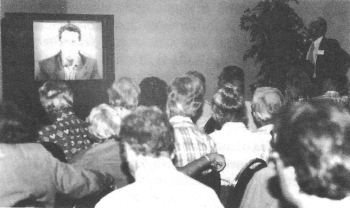
Attendees watch a video-tape screening of the “Donahue” show, which originally aired in March 1994, on which David Cole (shown on the screen) appeared as a guest along with Bradley Smith and Michael Shermer.
Germar Rudolf
In a statement read to the Conference, this years Mystery Speaker, Germar Rudolf, explained the reasons – including police raids and eviction as a result of political pressure – why he was not able to participate. Rudolf, a chemist who lives in southwest Germany, is the author of a technical study of the alleged mass-murder gas chambers at Auschwitz that confirms that these facilities were not and could not have been used to kill people as claimed.
David Cole
Speaking with verve and humor (often self-deprecating), youthful Jewish filmmaker David Cole enthralled his audience with a passionate response to a lengthy polemic against Holocaust revisionism (in which the work of the IHR and Cole were prominently featured) in a recent issue of Skeptic, a magazine published and edited by Michael Shermer. (Shermer, who had attended the previous days Conference sessions, was not present during Coles address.)
After Cole and other revisionists supplied the Occidental College associate professor with abundant evidence discrediting the Holocaust gas chamber story, an exasperated Shermer declared that the existence or non-existence of Nazi gas chambers doesnt really matter. With biting sarcasm, Cole commented: If the gas chambers dont matter, then why are we revisionists being persecuted for trying to revise such a minor detail? Try telling the ADL or the Wiesenthal Center that its a minor detail!
Cole, who had delighted attendees at the IHRs Eleventh Conference, has proven himself an effective spokesman for the revisionist view in several nationally-broadcast television appearances, including an appearance in March 1994 (with Shermer and Bradley Smith) as a guest on the Donahue Show. (See the May–June 1994 Journal, pp. 19–20).
In Coles first blockbuster revisionist video, the curator of the Auschwitz State Museum admitted to Cole on film that the gas chamber shown to tourists there is actually a fraudulent postwar reconstruction. Cole is now working on a promising second video exposing fraudulent claims about alleged wartime German killing facilities.
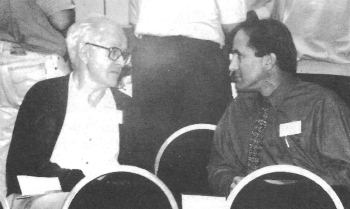
Robert Faurisson and Michael Shermer, editor-publisher of Skeptic magazine, exchange views during a Conference break.
Bradley Smith
Bradley Smith, Americas most prominent revisionist activist, reported on his successful headline-making campaign, in defiance of malicious smear tactics and ADL censorship, to bring revisionist facts and arguments to students and professors by placing advertisements in dozens of student papers across the United States. (See the July–August 1994 Journal, pp. 18–24)
Speaking in his familiar wry, soft-spoken and anecdotal style, Smith amused attendees with a description of his special relationship with adversaries Deborah Lipstadt and Jeffrey Ross of the Anti-Defamation League.
Dr. Robert Countess
Dr. Robert Countess, the IHRs roving ambassador and a member of the Journals Editorial Advisory Committee, updated attendees on his revisionist activities since the last Conference. As a college history instructor, he related, he assigned students to read Dr. Arthur Butzs revisionist classic, The Hoax of the Twentieth Century. Countess also reported on recent radio and television appearances, and suggested new ways to get out the word about Holocaust revisionism.

Guillermo Coletti, who was responsible for Conference security, with speaker Carlo Mattogno during a break in the proceedings.
Tom Marcellus
At the conclusion of this Conference, Institute Director Tom Marcellus hosted a special session for interested attendees about IHR business and organizational development in recent years, including the background and current situation arising from the termination in September 1993 of the IHRs association with Willis Carto.
Along with Mark Weber, Marcellus recounted the internal crisis that led to the termination, and reported on Cartos relentless campaign of outrageous lies against the IHR, above all through The Spotlight weekly that he controls. Marcellus and Weber also reported on Cartos efforts to destroy the Institute through lawsuits, and on the IHRs current legal action against Carto to recover millions of dollars that he illegally diverted from the IHR.
During this special session, Robert Faurisson explained how Cartos lies and deceit to him personally in the Spring and Summer of 1993 finally convinced him that Cartos continued involvement with IHR affairs was no longer tolerable.
Marcellus has been with the IHR since its founding in 1978, and has served as its Director since 1981 – except for an 18-month break in 1986 and 1987 during which the IHR Journal ceased publication and no new books were published. By contrast – and as Raven pointed out in his introduction of Marcellus – during the past twelve months, and in spite of intense legal harassment and media smears, the IHR – under Marcellus leadership – brought out five issues of the Journal, four books, a new catalog, and was able to organize this Twelfth IHR Conference.
In past years, members of the criminal Jewish Defense League attempted to sabotage several IHR conferences. This year, five agents of Willis Carto showed up to make a feeble attempt to wreck the gathering. Their efforts were entirely inconsequential, however, and after a short time they were escorted away by police.
Bibliographic information about this document: The Journal of Historical Review, vol. 14, no. 6 (November/December 1994), pp. 2-8
Other contributors to this document: n/a
Editor’s comments: n/a

